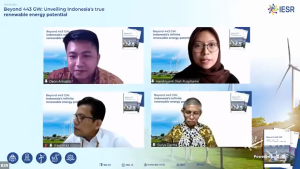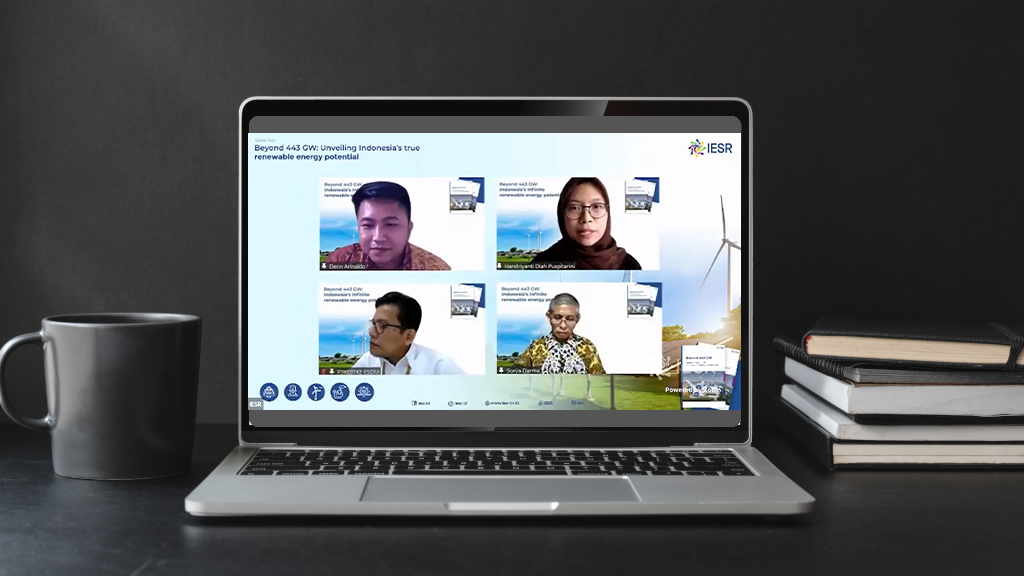Jakarta, October 25, 2021 – In order to encourage the acceleration of renewable energy development, the Institute for Essential Services Reform (IESR) launched a study entitled “Beyond 443 GW: Indonesia’s Infinite Renewables Energy Potentials”. This study contains data on mapping the technical potential of renewable energy in Indonesia using a Geographical Information System (GIS).
Fabby Tumiwa, Executive Director of IESR, in his opening speech hoped that this study could be a constructive input for the government and policy makers in planning and allocating their resources to utilize the potential of renewable energy as much as possible, both in terms of policy regulations and support from the State Budget.
“We hope that this potential mapping will also help local governments who are mandated to take advantage of the potential of renewable energy resources. They are also expected to encourage the use of renewable energy so that efforts to achieve decarbonization can be carried out together,” said Fabby.
This study states a total up to 7,879.4 GW (scenario 1) or 6,811.3 GW (scenario 2) renewable energy potential in Indonesia. It consists of solar (7,714.6 GW scenario 1 and 6,749.3 GW scenario 2), micro hydro ( 28.1 GW scenario 1 and 6.3 GW scenario 2), wind (19.8 GW – 106 GW), and biomass (30.73 GW).

Handriyanti Diah Puspitarini, the author of the ‘Beyond 443 GW’ study, in her presentation explained that the potential data was higher than the one stated in the National Energy General Plan (RUEN) document of 443 GW.
“The potential for renewable energy in Indonesia is very abundant, even more than what is needed to achieve deep decarbonization (or the 2050 zero emission target),” explained Handriyanti.
Through this ‘Beyond 443 GW’ study, IESR recommends the government to (1) update and review data on the technical potential of renewable energy on a regular basis as technology develops; (2) complete the necessary technical potential map with a brief analysis of the intermittent, variability, and network readiness; (3) consider a decentralized system and inter-island connections to ensure access and availability of electricity from renewable energy; (4) provide support for renewable energy technology innovations in order to open up greater utilization opportunities.
Present as a responder, Hariyanto, Head of the Center for Research and Technology Development (P3TEK) of the Ministry of Energy and Mineral Resources, stated that the results of this study could enrich the data on renewable energy potential because the Ministry of Energy and Mineral Resources is currently updating the technical potential data for renewable energy in Indonesia including solar, wind and solar, hydro, and bioenergy.
“From the results presented, currently there are the same numbers and there are different ones because I see there are different assumptions and scenarios. For example, the solar potential, which was originally 207.8 GW when updated, has a potential of 189 – 3,294.4 GW with various assumptions. We will still discuss with all stakeholders whether this figure can be put into practice,” explained Hariyanto.
Djoko Siswanto, Secretary General of the National Energy Council, welcomed this study and stated that the results of this study and the data currently being updated by the Ministry of Energy and Mineral Resources could be the basis for national and local governments in developing renewable energy. According to him, the national government can use the results of the latest renewable energy technical potential mapping as a consideration in the preparation of the National Grand Strategy Energy (GSEN), which is currently being carried out by the DEN.
Meanwhile, for local governments, the results of this mapping can be used as a basis for preparing the General Regional Energy Plan (RUED).
“DEN is currently facilitating the regions to draw up Perda RUED. The results of this mapping will be very useful in drafting Perda RUED which will later become the basis for Regional Governments in developing renewables in their respective regions,” Djoko added.
Still on the same occasion, Chairman of the Indonesian Renewable Energy Society (METI), Surya Darma stressed the importance of always updating data on potential renewable energy on a regular basis.
“The rapid development of technology and the different assumptions used can make the numbers fluctuate, but that’s okay. Our task is to find alternatives so that these potentials can be realized and really utilized,” said Surya Darma.

